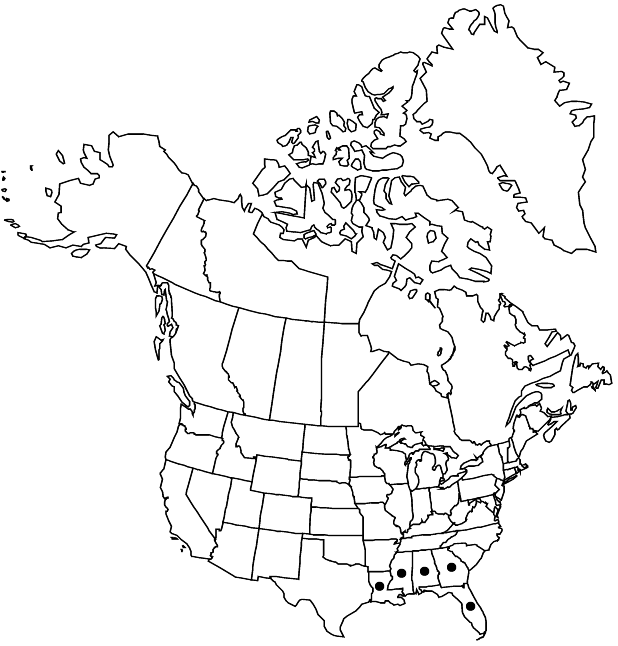Difference between revisions of "Gaylussacia mosieri"
Torreya 27: 36. 1927 ,.
FNA>Volume Importer |
imported>Volume Importer |
||
| (6 intermediate revisions by 2 users not shown) | |||
| Line 7: | Line 7: | ||
}} | }} | ||
|common_names=Hirsute huckleberry | |common_names=Hirsute huckleberry | ||
| + | |special_status={{Treatment/ID/Special_status | ||
| + | |code=E | ||
| + | |label=Endemic | ||
| + | }} | ||
|basionyms= | |basionyms= | ||
|synonyms={{Treatment/ID/Synonym | |synonyms={{Treatment/ID/Synonym | ||
|name=Lasiococcus mosieri | |name=Lasiococcus mosieri | ||
|authority=(Small) Small | |authority=(Small) Small | ||
| + | |rank=species | ||
}} | }} | ||
|hierarchy=Ericaceae;Ericaceae subfam. Vaccinioideae;Gaylussacia;Gaylussacia mosieri | |hierarchy=Ericaceae;Ericaceae subfam. Vaccinioideae;Gaylussacia;Gaylussacia mosieri | ||
| Line 26: | Line 31: | ||
|elevation=0-100 m | |elevation=0-100 m | ||
|distribution=Ala.;Fla.;Ga.;La.;Miss. | |distribution=Ala.;Fla.;Ga.;La.;Miss. | ||
| − | |discussion=<p>Gaylussacia mosieri is an eastern Gulf coastal plain endemic found in Sarracenia-dominated seepage bogs; it is related to G. bigeloviana, G. dumosa, and G. orocola and is easily distinguished by the glandular hairs on the hypanthium, bracts, pedicels, and twigs: 1–1.5 mm versus less than 0.5 mm for the other three species.</p> | + | |discussion=<p><i>Gaylussacia mosieri</i> is an eastern Gulf coastal plain endemic found in <i>Sarracenia</i>-dominated seepage bogs; it is related to <i>G. bigeloviana</i>, <i>G. dumosa</i>, and <i>G. orocola</i> and is easily distinguished by the glandular hairs on the hypanthium, bracts, pedicels, and twigs: 1–1.5 mm versus less than 0.5 mm for the other three species.</p> |
|tables= | |tables= | ||
|references= | |references= | ||
| Line 35: | Line 40: | ||
-->{{#Taxon: | -->{{#Taxon: | ||
name=Gaylussacia mosieri | name=Gaylussacia mosieri | ||
| − | |||
|authority=Small | |authority=Small | ||
|rank=species | |rank=species | ||
| Line 49: | Line 53: | ||
|publication title=Torreya | |publication title=Torreya | ||
|publication year= | |publication year= | ||
| − | |special status= | + | |special status=Endemic |
| − | |source xml=https:// | + | |source xml=https://bitbucket.org/aafc-mbb/fna-data-curation/src/2e0870ddd59836b60bcf96646a41e87ea5a5943a/coarse_grained_fna_xml/V8/V8_1039.xml |
|subfamily=Ericaceae subfam. Vaccinioideae | |subfamily=Ericaceae subfam. Vaccinioideae | ||
|genus=Gaylussacia | |genus=Gaylussacia | ||
Latest revision as of 23:41, 5 November 2020
Plants 3–10(–15) dm, forming small to extensive colonies; branches somewhat spreading; twigs of current season pale green, often finely glandular-hairy (hairs reddish). Leaves: petiole 1–2 mm; blade pale green abaxially, green adaxially, ovate to oblong, 2.5–5 × 0.7–2.5 cm, subcoriaceous, base cuneate, margins entire, apex rounded to obtuse, surfaces stipitate-glandular-hairy and eglandular-hairy (hairs relatively shorter), abaxial surface also sessile-glandular. Inflorescences spreading, 4–8-flowered, bracteate, 3–6 cm, often glandular-hairy (hairs silvery-silky, reddish, 1–1.5 mm); bracts persistent, leaflike, 5–12 mm at maturity, longer than pedicels, hairy and stipitate-glandular-hairy. Pedicels 5–7 mm, stipitate-glandular-hairy; bracteoles 1–2, 3–6 mm. Flowers: sepals 5, 2–3 mm, stipitate-glandular-hairy (hairs 1–1.5 mm); petals 4–5, corolla white or pinkish, campanulate, 6.5–8.5 mm (averaging 7.4 mm), lobes triangular, 1.2–1.7 mm; filaments 3–4 mm, glabrous; anthers included, 2.5–4.3 mm, thecae divergent distally; ovary stipitate-glandular-hairy (hairs 1–1.5 mm). Drupes juicy, sweet, glossy black, 6–9 mm diam., stipitate-glandular-hairy (hairs to 1 mm). Seeds 2–2.3 mm.
Phenology: Flowering spring.
Habitat: Pitcher plant bogs, hillside seepage bogs, wet pine savannas and flatwoods
Elevation: 0-100 m
Distribution

Ala., Fla., Ga., La., Miss.
Discussion
Gaylussacia mosieri is an eastern Gulf coastal plain endemic found in Sarracenia-dominated seepage bogs; it is related to G. bigeloviana, G. dumosa, and G. orocola and is easily distinguished by the glandular hairs on the hypanthium, bracts, pedicels, and twigs: 1–1.5 mm versus less than 0.5 mm for the other three species.
Selected References
None.